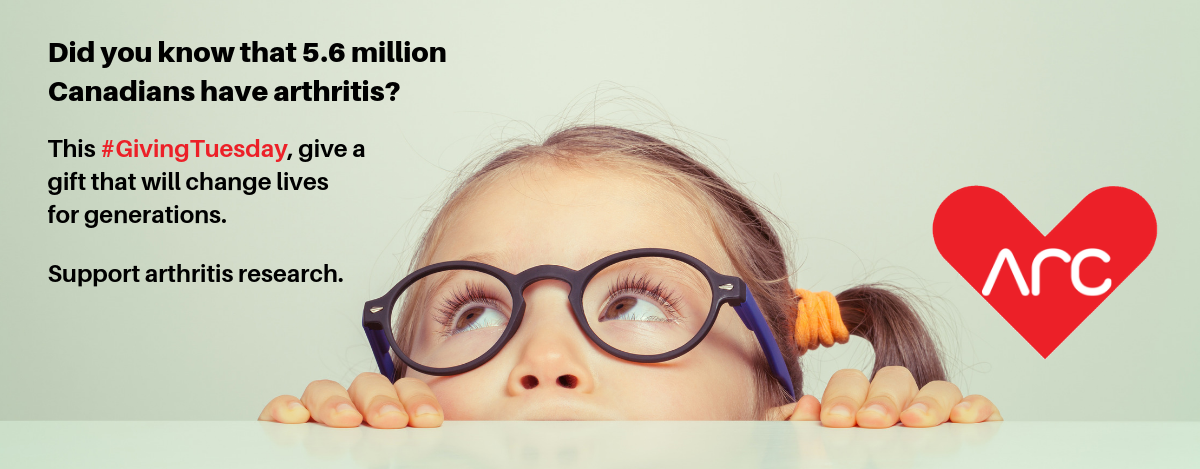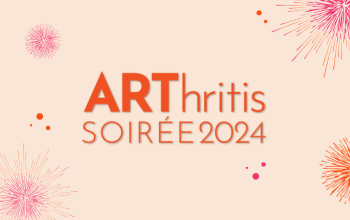News
Give a gift of hope this #GivingTuesday
Giving Tuesday kicks off the holiday giving season every year. It’s a time to celebrate giving, both in time and money, to causes that help others.
More than 5.6 million Canadians live with arthritis – a debilitating disease that can lead to serious and life-threatening complications. While there is no cure, research teams at Arthritis Research Canada are conducting over 75 studies aimed at arthritis prevention, early diagnosis and treatment, and quality of life issues.
Lori MacLean is a testament to the importance of arthritis research. She was diagnosed with rheumatoid arthritis – a chronic inflammatory disorder – as a toddler in 1979. She went into remission for the first time 36 years later thanks to medications that control her disease.
This giving Tuesday, please support arthritis research. The 350 million people around the globe who live with arthritis will thank you.
Lori’s story
By the time she was three, Lori had been to more doctor appointments, taken more medications, and felt more pain than many of us experience in a lifetime.

Lori at age two
“My mom noticed lumps on my wrists and ankles when I was around eight months old,” she said. “The pediatrician told her to wait and see…that they might go away on their own. But the lumps got bigger.”
That’s when Lori was diagnosed with rheumatoid arthritis. She was two years old.
“One of my earliest memories was getting cortisone injections,” she said.
This form of treatment involves injecting steroids into joints to relieve inflammation and, while effective, can be painful – especially for small children.
Rheumatoid arthritis took centre stage in Lori’s life for the next 36 years. The appointments, the injections, the medications, the pain – she knew nothing else.
“Every day revolved around monitoring my body and determining what I needed to treat,” she said. “Someone without arthritis doesn’t have to do that. They aren’t hyper aware of their body or joints. Those of us with arthritis feel every joint.”
It’s because of research that biologics came along and changed the landscape of arthritis treatment.
A new lease on life
In 2016, after nearly four decades with rheumatoid arthritis, Lori went into remission for the first time.
“Remission wasn’t something that ever crossed my mind,” she said. “I thought getting the pain to a minimum and the swelling down was the best outcome. And then I started feeling better and better.”
But for Lori, the most eye-opening part of remission has been discovering what life is like on the other side of rheumatoid arthritis.
“I didn’t know how my life was different from someone without arthritis,” she said. “I used to wake up and the first thing on my mind was that my knees or wrists ached. I would limp to a hot shower to help loosen my joints before doing anything else.”
Rheumatoid arthritis has affected the majority of Lori’s joints, except for her jaw and hips. She even has arthritis in her eyes and, from age 11 to 14, was legally blind. Lori now has no peripheral vision.
“I spent three years in a veil of fog, but I learned to adapt,” Lori said. “Not a lot of people realize rheumatoid arthritis can impact your eyes.”
Advancements in treatment
Lori grew up with arthritis and the treatments available to people with arthritis progressed too.
When she was a kid, Entrophen – a medication used to relieve pain, fever and inflammation – was one of the few options for treating arthritis.
“It’s basically just a pain reliever,” Lori said. “Gold injections were another option but my doctor resisted doing them because there was a small chance they could affect my vision.”
Arthritis treatments have advanced significantly since Lori was diagnosed in 1979.

“I can get up and make myself a cup of coffee. I don’t need a hot shower to be able to move.” – Lori
“It’s because of research that biologics came along and changed the landscape of arthritis treatment,” she said.
According to Arthritis Research Canada’s scientific director, Dr. John Esdaile, before biologics were released in the early 2000’s, people with rheumatoid arthritis had a greater risk of mortality within the first five years of diagnosis.
“Medications are reducing the risk of life-threatening complications and improving survival rates,” Dr. Esdaile said.
He added, today there are nearly two dozen drug options for treating rheumatoid arthritis.
“This progress is thanks to arthritis researchers who are dedicated to finding answers for the millions of people who suffer with the different forms of arthritis in Canada and around the globe,” Dr. Esdaile said.
Lori now gets HUMIRA injections and takes methotrexate. She described going for her first HUMIRA injection on a Wednesday and waking up on Thursday to notice the swelling in her wrists had gone down.
With reduced swelling, Lori is able to live her life. Arthritis is no longer the first thing she thinks about when she wakes up. Instead, she can get up and make herself a cup of coffee. She doesn’t need a hot shower to be able to move.
“I can do things without thinking about how to work around my arthritis,” Lori said. “I never thought that would be possible. This is why arthritis research is needed. It changes lives.”



























































